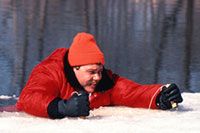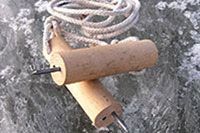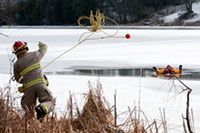Ice Fishing Safety
Recommendations for new, clear ice only
Call Nebraska Game and Parks for Ice conditions 763-2940.
Know that many lakes & ponds in Nebraska are spring fed so the ice thickness can have significant discrepancies.
Under 4 inches - STAY OFF.
Ice should be at least 4 inches for ice fishing or other activities on foot.
Ice should be at least 5 to 7 inches for snowmobile or ATV use.
Many factors other than thickness can cause ice to be unsafe.
White ice or "snow ice" is only about half as strong as new clear ice. You should double the above thickness guidelines when traveling on white ice.
What if you fall in?
What should you do if you fall through the ice? First, try not to panic. This may be easier said than done, unless you have worked out a survival plan in advance. Read through these steps so that you can be prepared.
Temperature, snow cover, currents, springs and rough fish all affect the relative safety of ice. Ice is seldom the same thickness over a single body of water; it can be two feet thick in one place and one inch thick a few yards away. As you walk to your fishing location use an ice spud to check the thickness. At a minimum check the ice thickness at least every 150 feet.

- Don’t remove your winter clothing. Heavy clothes won’t drag you down, but instead can trap air to provide warmth and flotation. This is especially true with a snowmobile suit.
- Turn toward the direction you came. That’s probably the strongest ice.
- Place your hands and arms on the unbroken ice surface. This is where a pair of nails, sharpened screwdrivers or ice picks comes in handy to providing the extra traction you need to pull yourself up onto the ice.
- Kick your feet and dig in your ice picks to work your way back onto the solid ice. If your clothes have trapped a lot of water, you may have to lift yourself partially out of the water on your elbows to let the water drain before starting forward.
- Lie flat on the ice once you are out and roll away from the hole to keep your weight spread out. This may help prevent you from breaking through the ice again.
- Get to a warm, dry, sheltered area and re-warm yourself immediately. In moderate to severe cases of cold water hypothermia, you must seek medical attention. Cold blood trapped in your extremities can come rushing back to your heart after you begin to re-warm. The shock of the chilled blood may cause your heart to beat irregularly and could lead to death!
Save Yourself!

Instructions for making Ice Claws
- Get two 4" pieces of wooden doweling the size of a broom handle or a little larger. Whatever material you select, it should float in case you drop the claws while struggling.
- Drive a stout nail into one end of each dowel. This should be a hardened 16 penny or larger concrete nail.
- Use a file to sharpen the nail heads to a point.
- Drill a hole into the dowels (in the end opposite the nail) and tie a length of strong cord through the hole so a pick is on each end "jump-rope" fashion. You may also drill a hole in the ends alongside the nails so the nail on the other pick can nest in the hole, keeping both points covered. Keep the picks in your pocket for quick emergency access if you or a companion does break through.
What if someone else falls in?
What if someone else falls through and you are the only one around to help?

- First, call 911 for help. There is a good chance someone near you may be carrying a cell phone.
- Resist the urge to run up to the edge of the hole. This may result in a second victim in the water (you). Also, do not risk your life to attempt to save a pet or other animal.
- Preach, Reach, Throw, Row, Go:
- PREACH - Shout to the victim to encourage them to fight to survive and reassure them that help is on the way.
- REACH - If you can safely reach the victim from shore, extend an object such as a rope, ladder, or jumper cables to the victim. If the person starts to pull you in, release your grip on the object and start over.
- THROW - Toss one end of a rope or something that will float to the victim. Have them tie the rope around themselves before they are too weakened by the cold to grasp it.
- ROW - Find a light boat to push across the ice ahead of you. Push it to the edge of the hole, get into the boat and pull the victim in over the bow. It’s not a bad idea to attach some rope to the boat, so others can help pull you and the victim to safety.
- GO – Only a trained professional should go out on the ice to attempt a rescue. A non professional shouldn’t go out on the ice to perform a rescue.
- If the situation is too dangerous for you to perform the rescue, call 911 for help and keep reassuring the victim that help is on the way and urge them to fight to survive. Heroics by well meaning but untrained rescuers sometimes result in two deaths.
Below are links to a couple of videos that provide lifesaving instructions for those that break through lake ice. Knowing what to do and what not to do may save a life.



